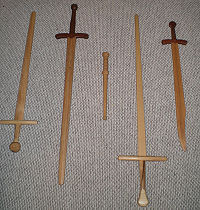| Waster | |
|---|---|
 | |
| Type | Practice Weapon |
| Place of origin | Western Europe |
| Service history | |
| In service | Late Bronze Age to current. Rare after the late 1800s. |
| Used by | Soldiers and Students |
| Specifications | |
| Mass | Longsword: 2–3 pounds (0.91–1.36 kg)
Arming Sword: 1–2 pounds (0.45–0.91 kg) Dagger: 0.5–1 pound (0.23–0.45 kg) |
| Length | Longsword: 42–50 inches (110–130 cm)
Arming Sword: 32–42 inches (81–107 cm) Dagger: 17–19 inches (43–48 cm) |
| Blade type | Wooden; lenticular (lens shaped) or diamond cross-section with blunted edges and tip |
| Hilt type | Wooden; generally cruciform and full-tang, with functional pommel, cross, and oval cross-section grip |
In martial arts, a waster is a practice weapon, usually a sword, and usually made out of wood, though nylon (plastic) wasters are also available. Nylon is safer than wood, due to it having an adequate amount of flex for thrusts to be generally safe, unlike wooden wasters. Even a steel feder has more flex than most wooden wasters. The use of wood or nylon instead of metal provides an economic option for initial weapons training and sparring, at some loss of genuine experience. A weighted waster may be used for a sort of strength training, theoretically making the movements of using an actual sword comparatively easier and quicker, though modern sports science shows that an athlete would most optimally train with an implement which is closest to the same weight, balance, and shape of the tool they will be using [citation needed]. Wasters as wooden practice weapons have been found in a variety of cultures over a number of centuries, including ancient China, Ireland, Iran, Scotland, Rome, Egypt, medieval and renaissance Europe, Japan, and into the modern era in Europe and the United States. Over the course of time, wasters took a variety of forms not necessarily influenced by chronological succession, ranging from simple sticks to clip-point dowels with leather basket hilts to careful replicas of real swords.
Used commonly in the modern historical European martial arts community, the term refers to wasters fashioned to resemble western European weapons like the longsword or arming sword. Historically, the term "waster" was used in English to refer to cudgels or clubs used as weapons, in addition to wooden swords. The increasingly popular historical martial arts reconstruction groups, as well as the live action role-playing and renaissance festival groups, have provided an ample market for commercial waster retailers. As the martial art has grown and academic interest has risen in weapons other than the longsword and arming sword, other types of wasters have been produced commercially.
The concept of wooden practice weapons is not limited to the historical european martial arts. Some Japanese martial arts involving swordsmanship, such as kenjutsu and iaido, use bokken or shinai as practice weapons. Eskrima, a martial art from the Philippines, also uses a type of rattan stick as a practice weapon in place of a blade. The martial art of singlestick is more or less entirely derived from the use of wasters as practice weapons in place of broadswords.